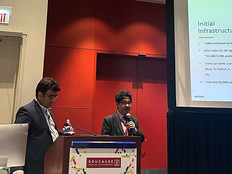Relay Graduate School Supports Growth with Hybrid Cloud
Relay Graduate School of Education is a decade old, having begun as Teacher U at Hunter College in 2007. In just the past two years, the school has doubled its number of campuses nationwide, from nine to 18, with a presence in locations such as Baton Rouge, Delaware, Houston and San Antonio.
As a result of that growth, Relay staff members don’t have legacy applications and aging infrastructure to deal with. Instead, they’re largely building out systems as they go, using a mix of cloud and on-premises resources, with the cloud making up a larger portion of that mix as time goes by.
“We’re a relatively young university, and we’ve never had a 100 percent on-premises data center,” says Edmund O’Neill, senior director of technology. “We’ve always had something in the cloud. But at the beginning, we started mirroring our peers with on-premises resources. Slowly, we started to chip away at that. Two years ago, we decided to move resources to the cloud as quickly as we could make it happen.”
MORE FROM EDTECH: Check out what to consider when adopting a cloud storage solution.
Hybrid Cloud Infrastructure Provides Extra Layer of Data Protection
The primary motivation, O’Neill says, is to secure reliable disaster recovery and business continuity. “If there’s a flood or a hurricane, we can’t afford for our campuses across the country to lose access,” he says.
Decisions about where to locate resources are made on a case-by-case basis. For instance, Relay is in the process of choosing a cloud productivity suite, but it’s keeping domain controllers in-house.
“The domain controllers are the key to all of our applications. They work with Active Directory and manage identity through our single sign-on solution,” says Joaquín Álvarez, senior director of technology products and support. “Mainly, it’s a matter of security. We keep it on-premises. But I want to emphasize that, with the way things are evolving, we are constantly exploring new options. So, we might be in the cloud a year from now.”
Even for a young institution like Relay, moving resources to the cloud takes time and requires training to bring along IT staffers. “The transition is not flipping a switch,” says Álvarez. “You’re going from a system that is so interwoven with this larger ecosystem of apps and tools, which forces you to carefully plan the transition. We want to expedite that.”
Recently, the university went live with a new enterprise resource planning solution, Unit4 Business World, which is running on the Azure Microsoft Cloud. O’Neill says that Relay’s staff can “roll with the punches pretty well,” but still can only handle so much change at once.
“You have to prepare people for it, you have to staff for it, you have to communicate it,” he says. “We began educating our staff about Unit4 a couple months before go-live, and so far, things have been very smooth. There’s a period of transition that you have to work through because these workloads get very ingrained in users’ lives, and of course any change projects of this size have rough patches. But by communicating openly about change with staff, we’ve found we can shorten the learning curve significantly.”
To learn more about how universities are taking advantage of hybrid cloud, check out "How to Use Hybrid Clouds to Manage Demand Peaks."






_1.jpg)



